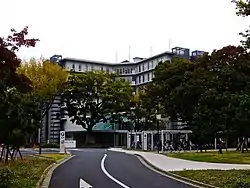| Tokyo Metropolitan Matsuzawa Hospital | |
|---|---|
 Front entrance of the Tokyo Prefectural Hospital in 2015 | |
| Geography | |
| Location | 2-1-1, Kamikitazawa, Setagaya-ku, Tokyo, Japan |
| Services | |
| Beds | 1,264 |
| History | |
| Former name(s) |
|
| Opened | 1879 |
| Links | |
| Website | www |
| Lists | Hospitals in Japan |
Tokyo Metropolitan Matsuzawa hospital (東京都立松沢病院, Tōkyō toritsu Matsuzawa byōin) is a public, 1,264-bed psychiatric hospital in Setagaya, Tokyo, Japan. It was founded in 1879. It is a hospital established and operated by the Tokyo Metropolitan Government, and is a general hospital equipped with other clinical departments as well as a psychiatric hospital.
Its address is 2-1-1, Kamikitazawa, Setagaya-ku, Tokyo. It is one of the largest centres for psychiatric care in Japan.[1]
History
Founded as the Tokyo Metropolitan Psychiatric Asylum in Ueno Park in July 1879, the institution relocated several times before moving to its current location in Setagaya in November 1919.[2]
Renamed to Sugamo Hospital in Tokyo in 1889.
In 1901, Shuzo Kure, the chief professor of the Department of Psychopathology at the Tokyo Imperial University, and serving as the director of Sugamo Hospital, and begins hospital reform. The major reforms include:
- Use of restraints is prohibited. Incinerate them all.
- Currently, physical restraints are used when it is unavoidable .
- Liberalization of outdoor exercise for patients, liberalization of exercise on the premises of hospitals accompanied by nursing staff and family members.
- We will replace leader-level staff such as the chief nurse who has a traditional view of nursing, and renew the staff and awareness of nursing staff.
- The new chief nurse will attend a nursing practice course at the Medical University Hospital to improve nursing skills.
- Improvement of patient treatment and renewal of treatment policy.
- Active use of occupational therapy.
- Execution of extension and renovation of the ward.
The hospital got the current name with the start of the metropolitan system in July 1943.
The Main Clinical Building was completed in May 2012.
During the COVID-19 pandemic, Matsuzawa Hospital accepted many COVID-19 patients with mental illnesses. By March 2021, seven hospital staff had become infected with the virus.[1]
Description

Matsuzawa Hospital is a public facility under the jurisdiction of the Tokyo Metropolitan Government.
As of 2023, it is a designated hospital for psychiatric emergency hospitalization in Tokyo and as a Tokyo disaster base hospital. As a general rule the hospital will provide medical treatment to anyone who is 15 years old or older. For patients who are 14 years old or younger they will be taken to the Tokyo Metropolitan Children's Medical Center.
Transport
The hospital is within walking distance of Hachimanyama Station on the Keiō Line.
Notable patients
- Kinjirō Ashiwara – admitted in 1882, having been diagnosed with hereditary mania.[3] The psychiatrists who later evaluated him, however, disagreed on the diagnosis of his condition; opinions were largely divided between paranoid schizophrenia and chronic mania.[4]
References
- 1 2 Kurokawa, Shinji (March 3, 2021). "Tokyo psychiatric hospital faced disaster-level workload amid coronavirus 3rd wave". The Mainichi.
- ↑ "History". Tokyo Metropolitan Matsuzawa Hospital. Retrieved March 15, 2021.
- ↑ Nakamura, Masaki; et al., eds. (February 20, 1983). 1930年: 恐慌と軍拡のはざまで [1930: Between Depression and Military Expansion]. 一億人の昭和史 [100 Million People's Shōwa-era History] (in Japanese). Vol. 39. Tokyo: The Mainichi Newspapers Co. p. 183. OCLC 959637831. NCID BN12487666.
- ↑ Okada, Yasuo (1981). 私說松沢病院史 1879–1980 [Private History of Matsuzawa Hospital 1879–1980] (in Japanese). Iwasaki Gakujutu Shuppansya. p. 115. OCLC 24983276. Retrieved May 26, 2023 – via Google Books.
(...) 芦原の病気はなんだったろうか? それには妄想型分裂病説と慢性躁病説とある。呉の臨床講義の写真に、芦原将軍がたっているわきの黒板に「偏執病/躁鬱病/妄想性痴呆/パラフレニーン」とかかれているものが (...)
External links
- Official website (in Japanese)
35°39′59″N 139°37′12″E / 35.66639°N 139.62000°E